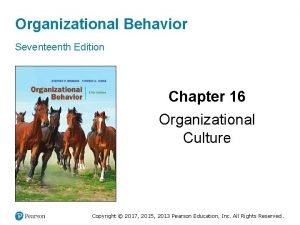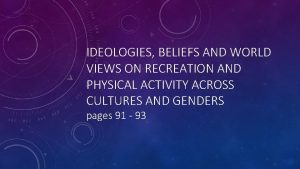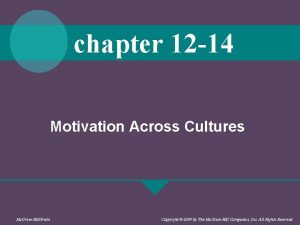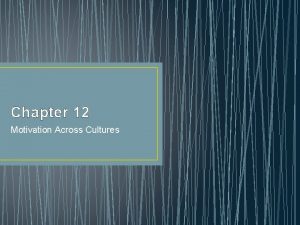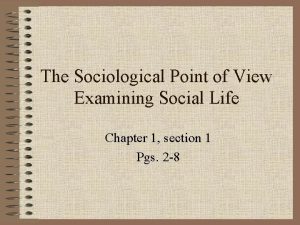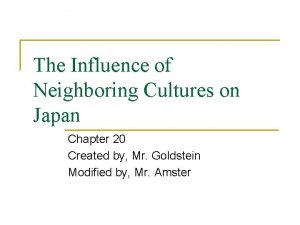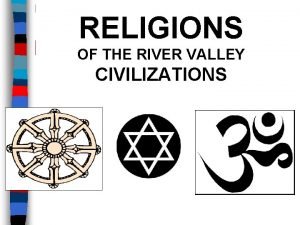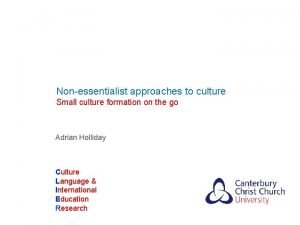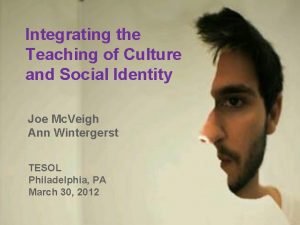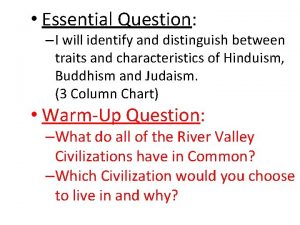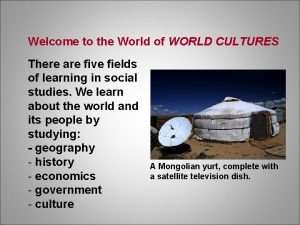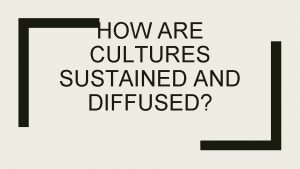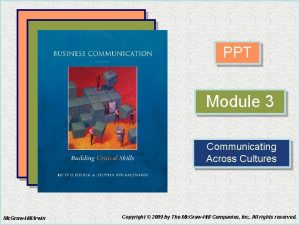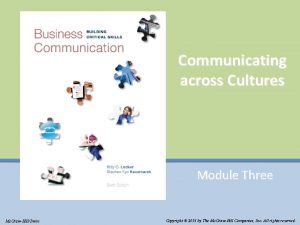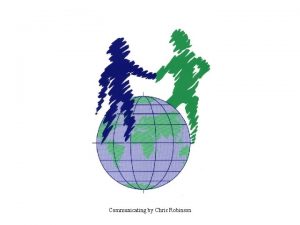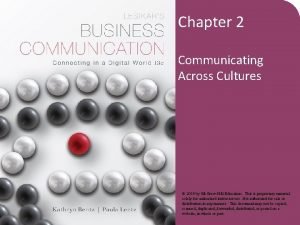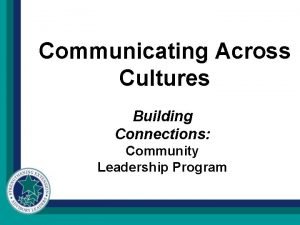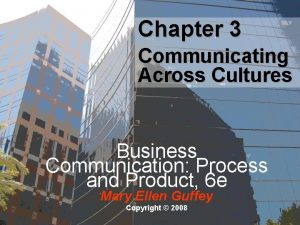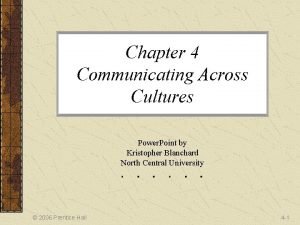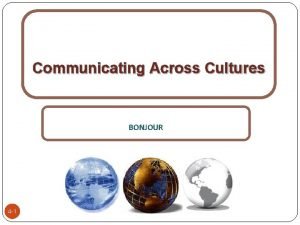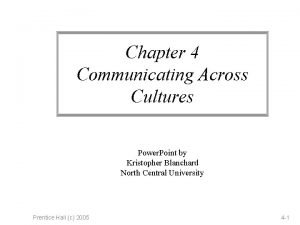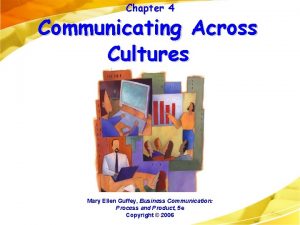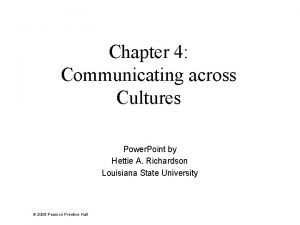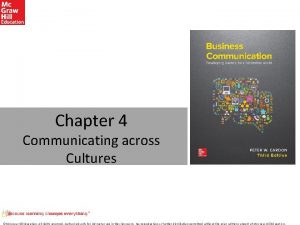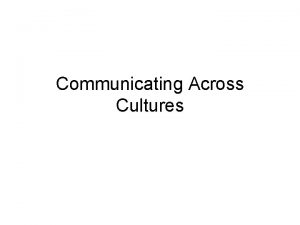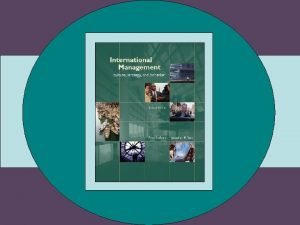PPT Module 3 Communicating Across Cultures Mc GrawHillIrwin






























- Slides: 30

PPT Module 3 Communicating Across Cultures Mc. Graw-Hill/Irwin Copyright © 2009 by The Mc. Graw-Hill Companies, Inc. All rights reserved.

Communicating Across Cultures ¨To learn how to § Consider diversity as part of audience analysis. § Begin to be aware of the values, beliefs, and practices in other cultures. § Become even more sensitive to verbal and nonverbal behavior. 3 -1

Communicating Across Cultures ¨To learn how to § Deal with discrimination. § Adapt to different expectations in the workplace. § Use bias-free language and photos. 3 -2

Communicating Across Cultures Start by answering these questions: § What is “culture”? § How does culture affect business communication? § There are so many different cultures! How can I know enough to communicate? 3 -3

Communicating Across Cultures Start by answering these questions: § Are differences among generations changing the workplace and how we communicate? § How can I make my documents bias -free? 3 -4

3 -5 Diversity and Culture Basics ¨ Diversity has always been with us— even if people didn’t recognize it or its value. ¨ No “one-size-fits-all” approach to working with cultural differences exists. § Use information here as guidelines. § Remember that people are individuals as well as group members.

Diversity and Culture Basics continued ¨ Be open to change and difference. ¨ Globalization is changing how we do business. § Services performed by non-U. S. workers are increasingly common. ¨ Offshoring of jobs will continue. § Forrester Research predicts 3. 3 million white-collar jobs to leave in the next 15 years. 3 -6

3 -7 Diversity in the Workplace ¨ Gender ¨ Race and ethnicity ¨ Regional and national origin ¨ Social class ¨ Religion ¨ Age ¨ Sexual orientation ¨ Physical ability

3 -8 Diversity in the Workplace continued ¨High-Context Cultures § Most information is inferred from the context of a message. § Little is “spelled out. ” § Examples: Japanese, Arabic, and Latin American cultures.

3 -9 Diversity in the Workplace continued ¨Low-Context Cultures § Context is less important than words. § Most information is spelled out; words are privileged. § Examples: German, Scandinavian, and dominant U. S. cultures.

3 -10 Diversity in the Workplace continued ¨Remember § In nations like the U. S. , Canada, and Brazil, multiple cultures exist. While the dominant culture may be privileged, recognize that minority cultures may have different norms with regard to behavior.

3 -11 Dimensions of Culture ¨ Values, Beliefs, and Practices ¨ Nonverbal Communication ¨ Body Language ¨ Eye Contact ¨ Gestures ¨ Space ¨ Spatial Arrangements ¨ Time ¨ Dress ¨ Colors ¨ Height ¨ Oral Communication ¨ Understatement, Exaggeration, and Silence

3 -12 Conversational Style ¨ How long a pause tells you that it’s your turn to speak? ¨ Do you see interruption as rude? ¨ Do you show interest by asking lots of questions?

3 -13 Communicating with Different Cultures ¨Brenda Arbalaez suggests being § Aware that values and behaviors are influenced by culture. § Flexible. § Sensitive. § Aware of the others’ values, beliefs, and practices. § Sensitive to differences among individuals.

3 -14 Generational Differences ¨ Different opinions on birth years, but in general: § Baby Boomers (post-WWII to middle 1960 s). § Generation X (middle 1960 s to early 1980 s). § Millennials (Early 1980 s to middle 1990 s). ¨ Some observers see challenges.

3 -15 Generational Differences continued ¨ Baby Boomers and Millennials § Two largest U. S. generations. § May differ in opinion on appropriate workplace · · · · · Dress. Ethics. Hierarchies. Expectations. Responsiveness. Autonomy. Goals. Technology. Communication.

3 -16 Generational Differences continued ¨Millennials’ strengths include § Multitasking. § Optimism. § Confidence. § Enthusiasm. § Organization. § Goal Orientation. § Technology use.

3 -17 Ways to Make Language Nonsexist ¨Use § Words that treat both sexes respectfully. § Titles that do not imply one sex “ought” to do a certain job. § The appropriate gender pronoun when referring to a specific person.

3 -18 Ways to Make Language Nonsexist continued ¨ Use § “Ms. ” As the courtesy title for a woman unless · The woman has a professional title. · You know that a woman prefers to be addressed by a traditional title.

3 -19 Ways to Make Language Nonsexist continued ¨When you write about anyone who may be in a job or position, make pronouns nonsexist. § Use plurals. § Use you. § Revise the sentence to omit the pronoun § Use pronoun pairs.

3 -20 Ways to Make Language Nonracist ¨Eliminate adjectives that reinforce negative stereotypes. § Biased: The motivated black students were assigned to internship positions throughout the company. § Bias-free: The students were assigned to internship positions throughout the company.

Ways to Make Language Nonracist continued ¨Identify race or ethnic origin only if it’s relevant. § Biased: Paloma Esteban, a Latino, has been appointed Vice-President of Finance. § Bias-free: Mike Waters, a Sioux, translated the governor’s speech into the Lakota language. 3 -21

Ways to Make Language Nonracist continued ¨Eliminate words and phrases with negative connotations. § Biased: Many of our managers who come from culturally deprived backgrounds now function as role models for young people through our mentoring program. 3 -22

Ways to Make Language Nonracist continued § Bias-free: Many of our managers whose family heritage is African, Asian, Spanish, or Appalachian now function as role models for young people through our mentoring program. 3 -23

3 -24 Talking about People with Diseases or Disabilities ¨Use “people first” language and avoid using adjectives as nouns. § Biased: · the alcoholic · the drug addict · the handicapped § Bias-free: · the woman who is an alcoholic · the man who abuses drugs · people with disabilities

3 -25 Talking about People with Diseases or Disabilities continued ¨Emphasize people’s abilities, not their limits or disabilities. § Biased: Jenny Ling has done an outstanding job as our spokesperson, even though she has diabetes. § Bias-free: Jenny Ling has done an outstanding job as our spokesperson for the past seven years.

Ways to Make Language Nonagist ¨Refer to age only if it’s truly relevant. § Biased: Tomoko Watanabe, 67, is president of Competitive Data Management. § Bias-free: Tomoko Watanabe is president of Competitive Data Management. 3 -26

Ways to Make Language Nonagist continued ¨Avoid stereotypes. § Biased: With her grandmotherly ways, good old Mary Grace makes everyone in Unit 2 feel special. § Bias-free: For the past 35 years, Mary Grace has been helping to create team spirit in Unit 2. 3 -27

Ways to Make Language Nonagist continued ¨Avoid negative labels for children, such as “children from broken homes. ” ¨Remember families can be singleparent and diverse. ¨Use nonsexist descriptions and images of children. 3 -28

3 -29 Bias Free Photos and Illustrations ¨Check visuals for bias. § Are the people diverse? § Are power relationships balanced? § Can you create your own visuals rather than rely on biased clip art?
 Communicating across cultures ppt
Communicating across cultures ppt Characteristics of organizational culture
Characteristics of organizational culture Communicating vs non communicating hydrocele
Communicating vs non communicating hydrocele Recreational activities across cultures and genders
Recreational activities across cultures and genders Body language across cultures respuestas
Body language across cultures respuestas Motivation in different cultures
Motivation in different cultures Motivation across cultures
Motivation across cultures Motivation across cultures
Motivation across cultures High context vs low context culture ppt
High context vs low context culture ppt C device module module 1
C device module module 1 Sub cultures
Sub cultures Which cultures believe in reincarnation
Which cultures believe in reincarnation What is sociology perspective
What is sociology perspective In what ways did neighboring cultures influence japan?
In what ways did neighboring cultures influence japan? Which cultures believe in reincarnation
Which cultures believe in reincarnation Which cultures believe in reincarnation
Which cultures believe in reincarnation Which cultures believe in reincarnation
Which cultures believe in reincarnation Small cultures
Small cultures Taste different cultures
Taste different cultures What is culture
What is culture Characteristics of collectivism
Characteristics of collectivism Personal sense of identity
Personal sense of identity Which cultures believe in reincarnation
Which cultures believe in reincarnation All cultures undergo
All cultures undergo How many cultures are there
How many cultures are there How are local cultures sustained
How are local cultures sustained High-context cultures emphasize nonverbal messages.
High-context cultures emphasize nonverbal messages. Chapter 20:3 puncturing the skin to obtain capillary blood
Chapter 20:3 puncturing the skin to obtain capillary blood Words from many cultures weslandia answers
Words from many cultures weslandia answers Broth cultures
Broth cultures Postfigurative cultures
Postfigurative cultures

